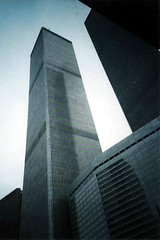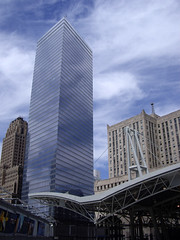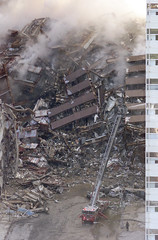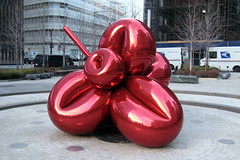|
To be designed by Frank Gehry, it will house the Joyce modern dance company, moving here from Chelsea. The building was going to house the Drawing Center art project as well, but it withdrew after an
absurd McCarthyite campaign led by The Daily News. A proposed International Freedom Center was also driven from the site by critics who feared it would be a venue for "controversial debate."
Site of 1 WTC

The WTC towers were not exactly twins; both were 110 stories, but the North Tower was slightly taller, at 1,368 feet, making it (briefly) the tallest building in the world, and the fifth tallest at the time of its destruction. (With its TV antenna, it was 1,728 feet.) Construction lasted from 1966-73; the towers opened in 1975. Windows on the World, located here, was the world's highest restaurant.

It was hit by American Airlines Flight 11 at 8:46 a.m. and collapsed at 10:28--the first tower to be hit but the second to collapse. One thousand, four hundred and two workers died in the attack, including 658 Cantor Fitzgerald employees, whose offices
were on the 101st-105th floors. Including the
passengers on the plane and the rescue workers, the majority of those killed on September 11 died at this address.
The sites of the towers are now a September 11 memorial called Reflecting Absence, designed by Michael Arad, featuring waterfalls descending into reflecting pools.
Site of 2 WTC
The South Tower had the world's highest outdoor
observation deck--1,362 feet.
It was hit by United Airlines Flight 175 at
9:05 a.m. and collapsed at 9:50. Five hundred
and ninety-nine occupants of this tower were
killed in the attack, only four of them below the
78th floor, the lowest hit by the plane.
160:
Madame Restell, New York's
most prominent abortion provider,
lived here before moving to an
opulent mansion on 5th Avenue.
154: The address of Edward Smith's
Candy Store; his son, John T. Smith, lived
on the upper floors from 1869 until
1938, when he died with an estate
worth $3 million.
148: Madame Restell
opened her offices here in 1839.
|
|
Site of 5 WTC
200 (corner): Was the nine-story Dean Witter Building, destroyed in the September 11 attacks. Future site of 2 World Trade Center, aka 200 Greenwich Stret, a planned 88-story building that will rise to 1,349 feet--99 feet taller than the Empire State Building (not counting the antenna spire). The Foster and Partners design features a distinctive cluster of four diamond-shaped spires.
It's not
clear why they didn't put follow the convention
of the rest of Greenwich Street (and the city
in general) and put even numbers on the west
side of the street.
175: Future site of WTC Tower 3 (2012)
150: Future site of WTC Tower 4 (2012)
Site of 6 WTC
The nine-story Commodities Exchange Building,
destroyed in the September 11 attacks
|






